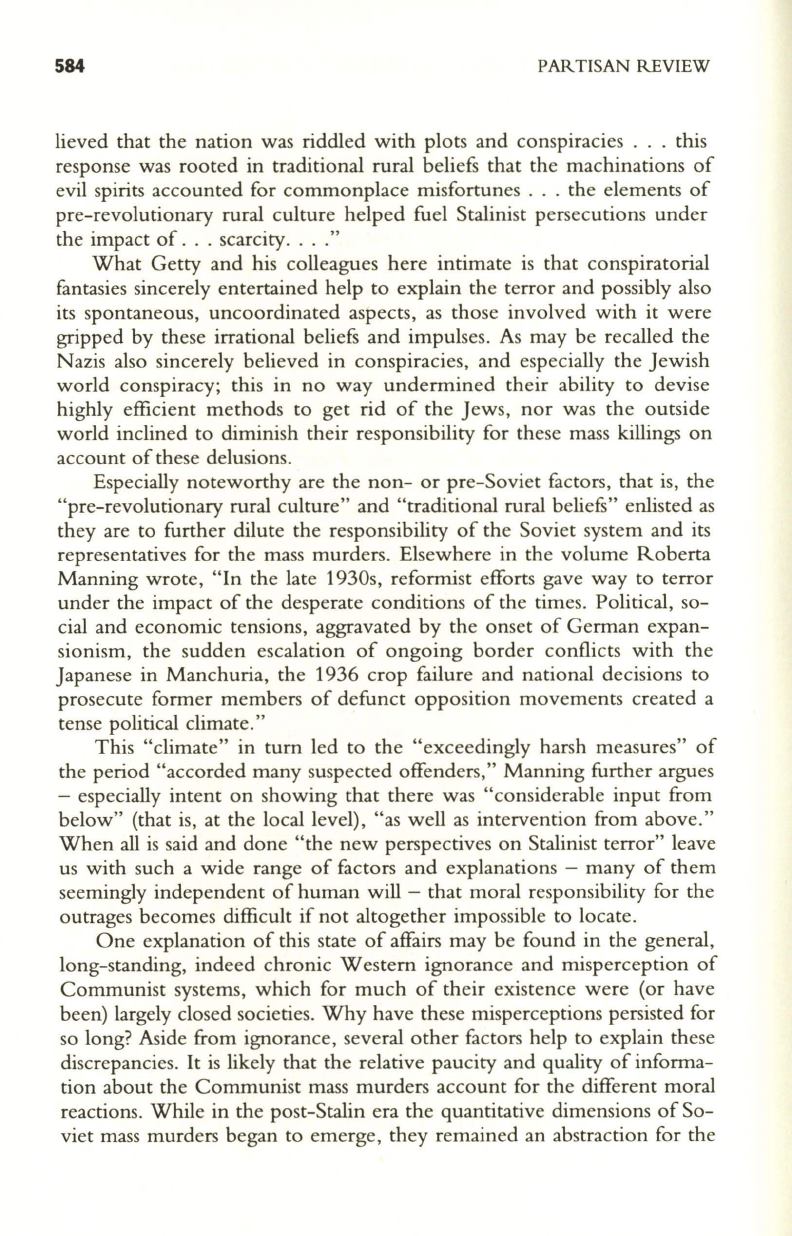
584
p
ARTISAN REVIEW
lieved that the nation was riddled with plots and conspiracies ... this
response was rooted in traditional rural beliefs that the machinations of
evil spirits accounted for commonplace misfortunes . . . the elements of
pre-revolutionary rural culture helped fuel Stalinist persecutions under
the impact of ... scarcity.... "
What Getty and his colleagues here intimate is that conspiratorial
fantasies sincerely entertained help to explain the terror and possibly also
its spontaneous, uncoordinated aspects, as those involved with it were
gripped by these irrational beliefs and impulses. As may be recalled the
Nazis also sincerely believed in conspiracies, and especially the Jewish
world conspiracy; this in no way undermined their ability to devise
highly efficient methods to get rid of the Jews, nor was the outside
world inclined to diminish their responsibility for these mass killings on
account of these delusions.
Especially noteworthy are the non- or pre-Soviet factors, that is, the
"pre-revolutionary rural culture" and "traditional rural beliefs" enlisted as
they are to further dilute the responsibility of the Soviet system and its
representatives for the mass murders. Elsewhere in the volume Roberta
Manning wrote, "In the late 1930s, reformist efforts gave way to terror
under the impact of the desperate conditions of the times. Political, so–
cial and economic tensions, aggravated by the onset of German expan–
sionism, the sudden escalation of ongoing border conflicts with the
Japanese in Manchuria, the 1936 crop failure and national decisions to
prosecute former members of defunct opposition movements created a
tense political climate."
This "climate" in turn led to the "exceedingly harsh measures" of
the period "accorded many suspected offenders," Manning further argues
- especially intent on showing that there was "considerable input from
below" (that is, at the local level), "as well as intervention from above."
When all is said and done "the new perspectives on Stalinist terror" leave
us with such a wide range of factors and explanations - many of them
seemingly independent of human will - that moral responsibility for the
outrages becomes difficult if not altogether impossible to locate.
One explanation of this state of affairs may be found in the general,
long-standing, indeed chronic Western ignorance and misperception of
Communist systems, which for much of their existence were (or have
been) largely closed societies. Why have these misperceptions persisted for
so long? Aside from ignorance, several other factors help to explain these
discrepancies.
It
is likely that the relative paucity and quality of informa–
tion about the Communist mass murders account for the different moral
reactions. While in the post-Stalin era the quantitative dimensions of So–
viet mass murders began to emerge, they remained an abstraction for the


